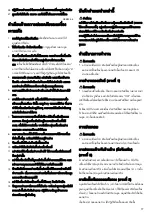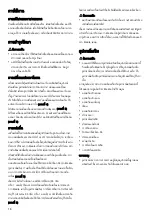
5
11.
Do not leave the tool running. Operate the tool
only when hand-held.
12.
Do not point the tool at any one in the area when
operating. The bit could fly out and injure
someone seriously.
13.
Do not touch the bit or parts close to the bit
immediately after operation; they may be
extremely hot and could burn your skin.
14.
Do not operate the tool at no-load unnecessarily.
15.
Some material contains chemicals which may be
toxic. Take caution to prevent dust inhalation and
skin contact. Follow material supplier safety data.
SAVE THESE INSTRUCTIONS.
WARNING:
DO NOT let comfort or familiarity with product (gained
from repeated use) replace strict adherence to safety
rules for the subject product.
MISUSE or failure to follow the safety rules stated in
this instruction manual may cause serious personal
injury.
FUNCTIONAL DESCRIPTION
CAUTION:
• Always be sure that the tool is switched off and
unplugged before adjusting or checking function on the
tool.
Switch action (Fig. 1)
CAUTION:
• Before plugging in the tool, always check to see that
the switch trigger actuates properly and returns to the
“OFF” position when released.
To start the tool, simply pull the switch trigger. Release the
switch trigger to stop.
For continuous operation, pull the switch trigger and then
push in the lock button.
To stop the tool from the locked position, pull the switch
trigger fully, then release it.
ASSEMBLY
CAUTION:
• Always be sure that the tool is switched off and
unplugged before carrying out any work on the tool.
Installing side grip (auxiliary handle)
(Fig. 2)
The side grip swings around to either side, allowing easy
handling of the tool in any position. Loosen the side grip
by turning it counterclockwise, swing it to the desired
position and then tighten it by turning clockwise.
Installing or removing the bit (Fig. 3)
Pivot the tool retainer to the side.(If it is difficult to move
the tool retainer with your thumbs, tap it with a hammer.)
Insert the bit into the tool barrel as far as it will go. Return
the tool retainer to its original position to secure the bit.
To remove the bit, follow the installation procedure in
reverse.
OPERATION
Chipping/Scaling/Demolition
Hold the tool firmly with both hands. Turn the tool on and
apply slight pressure on the tool so that the tool will not
bounce around, uncontrolled. Pressing very hard on the
tool will not increase the efficiency.
MAINTENANCE
CAUTION:
• Always be sure that the tool is switched off and
unplugged before attempting to perform inspection or
maintenance.
• Never use gasoline, benzine, thinner, alcohol or the
like. Discoloration, deformation or cracks may result.
Replacing carbon brushes
When the resin insulating tip inside the carbon brush is
exposed to contact the commutator, it will automatically
shut off the motor. When this occurs, both carbon brushes
should be replaced. Keep the carbon brushes clean and
free to slip in the holders. Both carbon brushes should be
replaced at the same time. Use only identical carbon
brushes.
(Fig. 4)
Use a hex wrench to remove the rear cover.
(Fig. 5)
Use a screwdriver to remove the brush holder caps. Take
out the worn carbon brushes, insert the new ones and
secure the brush holder caps.
(Fig. 6)
Lubrication
This tool requires no hourly or daily lubrication because it
has a grease-packed lubrication system. It should be
relubricated after every 6 months of operation. Send the
complete tool to Makita Authorized or Factory Service
Center for this lubrication service. However, if
circumstances require that you should lubricate it by
yourself, proceed as follows.
Run the tool for several minutes to warm it up. Switch off
and unplug the tool.
Remove the crank cap using a Makita lock nut wrench 35
(optional accessory). Rest the tool on the table with the bit
end pointing upwards. This will allow the old grease to
collect inside the crank housing.
(Fig. 7)
Wipe out the old grease inside and replace with a fresh
grease (30 g; 1 oz). Use only Makita genuine hammer
grease (optional accessory). Filling with more than the
specified amount of grease (approx. 30 g; 1 oz) can cause
faulty hammering action or tool failure. Fill only with the
specified amount of grease.
(Fig. 8)
Reinstall the crank cap and tighten with the lock nut
wrench.
CAUTION:
• Do not tighten the crank cap excessively. It is made of
resin and is subject to breakage.
To maintain product SAFETY and RELIABILITY, repairs,
any other maintenance or adjustment should be
performed by Makita Authorized Service Centers, always
using Makita replacement parts.






































